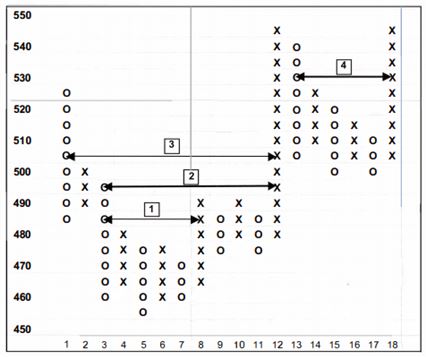Horizontal Counts On 3-box Reversal Charts
In the last unit, we have learned vertical counts on 3-box reversal charts; now, let us learn horizontal counts on 3-box reversal charts.
The horizontal count measures the width of any congestion top or bottom pattern and calculates it by 3 times that width.
Horizontal counts do yield worthwhile targets and should be used whenever possible, especially where they confirm vertical counts.
How to establish upside targets using the horizontal count method on 3-box charts
Step 1–We have to look for a congestion pattern at the bottom.
Look for any bottom patterns at the end of a downtrend that have the shape of a U, V or W.
The shape of the pattern is not so important, but it must have walls.
There must be a column of 0s entering it and a column of Xs leaving it.
Between the entry and exit columns, there must be some consolidation or congestion for the count.
Step 2 - Count the number of columns in the pattern
Once the entry and exit columns have been chosen, count the number of columns across the pattern, including the entry column of 0s and the exit column of Xs.
Multiply the number of columns by the box size (the value of each X and 0).
Multiply this value by the reversal, which is 3.
- Add this total to the value of the lowest 0 in the pattern.
You now have the upside target, which you may mark on the chart.

Horizontal upside counts on a 3-box reversal chart showing rows that may be counted.
There is a big bottom pattern bounded by columns 1 and 12. This allows a count to be established. Target = (number of columns in the larger pattern) x (box size) x (reversal) + lowest low between columns 1 and 12 There are 12 columns between the walls (including the walls), the box size is 5 and the reversal is 3. The value of the lowest 0 in the pattern is still in column 5, which is 455. Target = (12 x 5 x 3) + 455 = 635.


